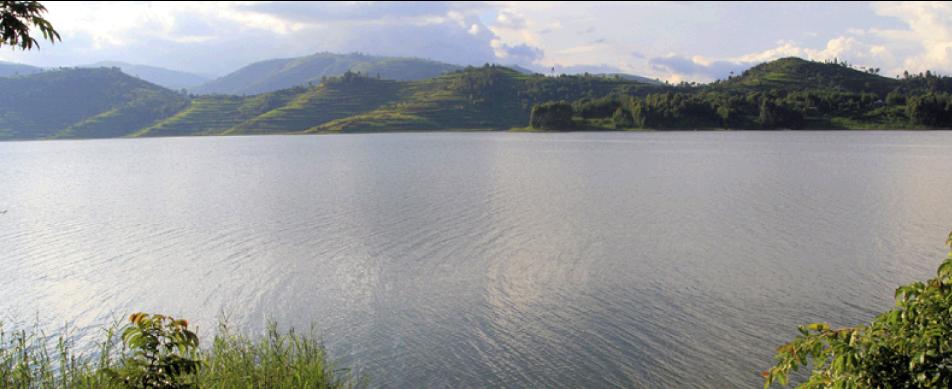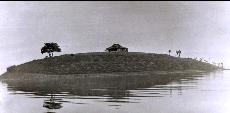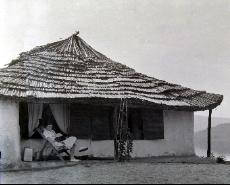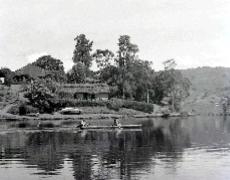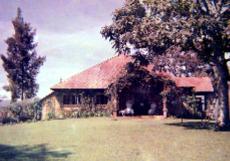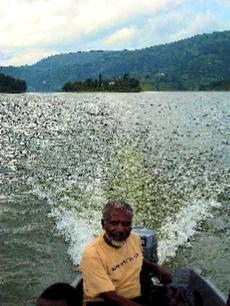IN SEARCH OF PARADISE
In The Ghosts of Eden my character Michael comes across a book called In Search of Paradise. I use the title to hint heavily at Michael’s own yearnings but a book, by the same name and with a strong personal connection, was written by Stephen Lister in the 1950s. He travelled the world looking for the perfect spot to retire. On Lake Bunyoni in southern Uganda, he came across an island and wrote: It was 'not only the loveliest and most delightful spot I saw in Africa, but I am also tempted to say in the world’. Carried to the island in a long dug-out canoe the ‘island of his dreams’ appeared ‘through a light opalescent haze. The house was there, beautifully shabby, as though it was a natural part of the island. The green lawns, cropped and velvety, swept down to the water's edge. It was like seeing a ghost, so faithfully did it tally with my dream picture’.
The island belonged to my grandparents. The story of how they came to be there requires a little history.
Rebellion
During the First World War rebellion was in the air around Lake Bunyoni against the colonial authorities. Some local chiefs with links to the powerful Nyabingi sect mounted raids along the shores of the lake. The Nyabingi practitioners performed their ceremonies on three islands and when the drums sounded canoes would converge on the islands bringing gifts of goats, sheep, girls and beer. The police fought back and a leader of the rebellion retreated to one of the islands, commandeering all the canoes on the lake. The police were helpless until another boat was found on a far away lake and carried by a team of over a hundred porters over high hills and through thick bamboo forest to reach Bunyoni. The sect, seeing themselves outgunned, fled, leaving the islands deserted with only a few scraggly trees remaining as a reminder of the rituals performed beneath their branches.
Leprosy
My grandparents, Len and Esther, came out to Uganda at the end of the First World War. Len was a doctor and was shocked by the suffering of those with leprosy. The disease was common and could result in hideous deformities. They lobbied the government to designate the islands for a leprosarium where patients and their families could settle to benefit from treatment and rehabilitation. With his team Len built villages, a hospital, a school, a football pitch and a church with a tall steeple on the largest island.
The Island of his Dreams
Len and Esther set up camp on the smallest of the three islands and built a house. They called it The White Cottage (Njuyera) after Len’s parents’ home on the Isle of Wight in England. The island was almost devoid of vegetation when they pitched their tent but over the years Esther created a spectacular garden with flame lilies and roses, lemon and guava trees. A lawn swept down from the house to the lake’s edge; a tennis court was levelled using volcanic ash from the nearby volcanoes. By the time Stephen Lister visited in the 1950s, Njuyera - Sharp’s Island had become famous throughout East Africa. With its Cyprus trees and lawns it resembled an island on an Italian lake.
Despite the painful treatment, which involved weekly injections of hydnocarpus oil (first used at least 600BC), by 1948 there were a thousand residents on the island and forty seven thousand injections were given each year. Many patients recovered and returned to their home villages. By the mid 1950s advances in medical treatment meant that patients could return to the mainland to be treated in local clinics. Len and Esther left Njuyera - Sharp’s Island in 1961 to retire to Mombasa, never returning to Britain.
Paddle
The island is open to tourists and still has its old charm. The ghosts of my grandparents haunt the overgrown gardens and there are still those on the lake shore who remember their work.
Read more at 100 Years Ago Dr Leonard Sharp Revolutionised Lake Bunyonyi – Gorilla Highlands Experts
